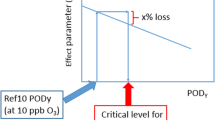Abstract
This paper describes the results of a series of experiments designed to identify the relative importance of various factors which modify the responses of a sensitive species to ozone. The experiments were conducted in a closed chamber exposure system, enabling clover plants (Trifolium subterraneum L. cv Geraldton) to be exposed to ozone doses ranging from 0 to 1800 ppb.h, accumulated over 40 ppb (AOT40), for 7 h d−1, over 1 to 3 days. Microclimatic conditions during exposure ranged from 80 to 460 μmol m−2 s−1 photosynthetically active radiation (PAR), 26 to 61 percent relative humidity (%RJH) and 16 to 36 °C temperature. No clear dose response relationships were established for 1, 2 or 3 day exposures due to the influence of microclimatic and other factors during exposure. Artificial Neural Networks were used as a tool to identify patterns within the dose response data set and to clarify the effects of various microclimatic and dose topography responses, during multiple day exposures. Analysis of the trained neural network revealed that AOT40 on individual exposure days was the most important influences PAR on the first and third days of exposure, the mean relative humidity and the mean temperature for all days also had strong influences. Leaf age also had an influence but this was weaker. This paper describes these results in relation to the influences acting upon the plant and how these affect ozone uptake and resulting ozone injury.
Similar content being viewed by others
References
Balls, G. R., Palmer-Brown, D. and Sanders, G. E.: (In Press), a, “Artificial Neural Networks: A Novel Approach to Studying Microclimate-Ozone Interactions in Clover (Trifolium subterraneum L. cv. Geraldton).”, Submitted to New Phytologist.
Dayhoff, J.E.: 1990, “Neural network architectures: An introduction.”, Van Nostrand Reinhold. 1–20.
Fuhrer. 1994: “The critical level for ozone to protect agricultural crops — An assessment of data from European open-top chamber experiments.” Proceedings of the Critical Levels for Ozone Workshop, number 16, Bern Switzerland 1–4 November (1993), 42–57.
Kappen, L. and Haeger, S.:1991, “Stomatal responses of Tradescantia albiflora to changing air humidity in light and darkness.”, Journal of Experimental Botany, 42, 979–986.
Kersteins, G., Federholzner, R. and Lendzian, K.J.: 1992, “Dry deposition and cuticular uptake of pollutant gasses. ”, Agriculture, Ecosystems and Environment, 42, 239–253.
Mortensen, L. M.: 1992, “Effects of ozone concentration on growth of tomato at various light, air humidity and carbon dioxide levels.”, Scientia Horticulturae, 49, 17–24.
Pihl Karlsson, G., Sellden, G., Skarby, L. and Pleijel, H.: 1995, “Clover as an indicator for phytotoxic ozone concentrations: visibly injury in relation to species, leaf age and exposure dynamics.”, New Phytologist, 129, 355–365.
QUARG: 1993, “Urban Air Quality in the United Kingdom: First report of the Quality of Urban Air Review Group”, UK Department of the Environment, London.pp 111–116.
Tjoelker, M.G., Volin, J.C., Oleksyn, J. and Reich, P.B.: 1993, “Light environment alters response to ozone stress in seedlings of Acer saccharum Marsh. and hybrid Populus L.”, New Phytologist, 124, 627–636.
UNECE.: 1993, “Manual on methodologies and criteria for mapping critical levels/loads and geographical areas where they are exceeded.”. Texte 25/93, Umweltbundesamt, Bismarckplatz 1, W-1000 Berlin 33, Germany.
Author information
Authors and Affiliations
Rights and permissions
About this article
Cite this article
Balls, G.R., Palmer-Brown, D., Cobb, A.H. et al. Towards unravelling the complex interactions between microclimate, ozone dose, and ozone injury in clover. Water Air Soil Pollut 85, 1467–1472 (1995). https://doi.org/10.1007/BF00477188
Issue Date:
DOI: https://doi.org/10.1007/BF00477188




